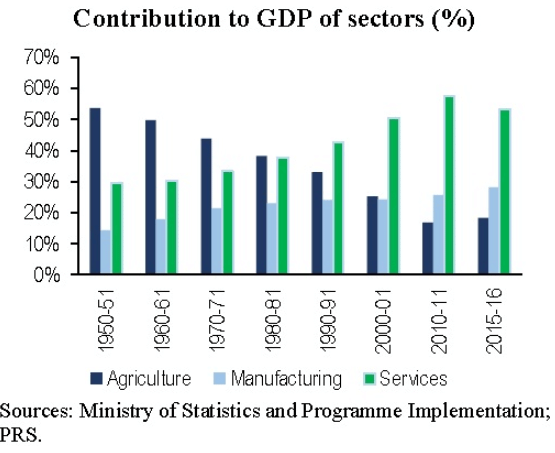UPSC Exam > UPSC Notes > Indian Economy for UPSC CSE > Structural Changes & India: A Mixed Economy
Structural Changes & India: A Mixed Economy | Indian Economy for UPSC CSE PDF Download
Structural Changes
- During the planning period Indian economy has not only grown but has witnessed structural changes also.
- Economic structure implies interrelationship among the different productive sectors such as agriculture and allied sectors (primary sector), manufacturing and industries (tertiary sector). Low level of economic development is characterised by predominance of primary sector.

- Predominance of any sector is determined from the sectoral composition of national income and occupational structure.
- An economy is considered to be predominated by primary sector when the contribution of this sector in the national income is largest and the bulk of the population is dependent on this sector for its subsistence.
- Moreover in this economy the importance of the secondary and tertiary sector is less both in terms of sectoral composition of national income and development proceeds, the importance of primary sector (in terms of sectoral composition of national income and occupational pattern) starts declining and that of secondary and tertiary sectors starts increasing. The structural changes that have taken place in India during the planning period are :
Sectoral Composition of National Income :
- An important measure of development is a steady decline in the importance of primary sector of agriculture and allied activities, in terms of their contribution to GDP, in the economy.
- In 1950-51, the contribution of primary sector towards India's GDP was 56.5 percent which has since then fluctuated between 56.5 and 31.3 percent.
- However, since 1970-71 there has been a steady decline in total contribution and was 28.6 percent in 1995-96.
- On the other hand, the contribution of secondary sector which was 15 percent of GDP in 1950-51 rose to 29.2 percent in 1995-96 due to growth in industries.
- Similarly the contribution of tertiary sector to GDP during the planning period has risen from 28.5 percent in 1950-51 to 41.2 percent in 1995-96.
- Sectoral contribution in GDP New series (at constant 2011-12 prices) for 2014-15: Agriculture and allied sector – 17.6% Industry –29.7% and service sector –52.7%.

Stable Occupational Distribution
- Occupational distribution in a developing economy rapidly shifts from primary sector to secondary and tertiary sectors.
- In India occupational distribution has not changed significantly during the plan period, though the economy as a whole has recorded a fairly significant growth.
- According to V.K.R.V. Rao, India's occupational structure exhibits 'structural retrogression.' In spite of development efforts in the country during the plan period there has been no significant change in occupational structure because
- Rapid rise in population;
- Less progress in agricultural sector; and
- Absence of fast industrialization and hence sluggish growth of the tertiary sector.
Remember The Facts |
|
Development of Basic Capital Goods
- At independence underdevelopment in Indian industrial structure was particularly glaring in basic capital goods industries.
- Very few basic capital goods industries were established and their share in the total industrial production was 25 percent only.
- In Second Five Year Plan the focus was on basic capital goods industries since their development was essential for an overall growth of the economy.
- Hence a large number of capital goods industries were established which now account for more than 50% of the total industrial production.
Social Capital Formation
- Social capital includes transport, energy, education, health etc., Building up of social capital helps in better and quicker economic growth.
- India's transport system during the plan period has grown both in capacity and modernisation.
- We have made rapid progress in electricity production and irrigation.
- But education and health facilities have not grown at a desired rate.
Banking and Social Sector
- Since independence, the organisation of money and capital market has improved, specialised industrial financing institutions have been set up, banking services have increased and modern banks have reached small towns and villages.

- After nationalisation of banks in 1969 there has been a radical change in the credit policy.
- More funds are available to priority sectors like agriculture, small scale industries, transportation etc.
- Indian economy exhibits dualistic nature—a modernised economy exists alongside a traditional primitive economy.
- The traditional rural sector in India is associated with following features : it is engaged in peasant cultivation, handicrafts and small-scale industries it has variable technical coefficients so that the commodities can be produced with the help of a wide range of techniques and alternative combination of labour and capitaly and labour is relatively abundant factor of production, so that techniques of production are primarily labour-intensive.
- In the modern sector which is composed of large scale industries, mines and plantations, there is a very limited degree characterised by fixed technical coefficients and the production process is relatively capital intensive.
India : A Mixed Economy
- The term mixed economy refers to an economic system where some planning of production is undertaken by the state, directly or through its nationalised industries (public sector) and some is left to private enterprise.
- The principle of mixed economy is based on the amalgamation of the best of the both capitalist and socialist system. India is a classic example of mixed economy. Since independence India has a fairly well-developed public sector along with the private enterprise.
- This mixed economy principle finds expression in the Government of India's Industrial Policy Resolution of 1948 and 1956.
- The Second Five Year Plan (1957-62) envisaged a planned development based on 'socialist pattern of society' implying that the basic criterion for determining lines of advance must not be private profit but social gain though a socialistic pattern of society still remains a far cry.
- Planning in India has been mistakenly identified as socialistic, merely because planning got associated with socialism as only socialistic countries first adopted planning for economic development.
- However, Indian economy is also different, in many respects, from the capitalist economies of the 18th century Europe.
- The two factors, viz, growth of the public sector and economic planning in India make the Indian economy different from the capitalist economy.
- India has adopted economic planning which is basically of capitalist structure, has limited range and lacks the element of compulsion. In socialist countries there is an element of compulsion in implementation of plans and realisation of the targets.
In short, the features of India's economy which characterise it as a mixed economy are :
- private -ownership of the means of production;
- predominance of market mechanism though not completely free from state control;
- increase in monopoly trend;
- presence of large public sector along with free (private) enterprise; and
- economic planning, different from the one in socialist economy, in a capitalistic economic framework.
The document Structural Changes & India: A Mixed Economy | Indian Economy for UPSC CSE is a part of the UPSC Course Indian Economy for UPSC CSE.
All you need of UPSC at this link: UPSC
|
108 videos|425 docs|128 tests
|
FAQs on Structural Changes & India: A Mixed Economy - Indian Economy for UPSC CSE
| 1. What are the structural changes in India's mixed economy? |  |
Ans. India's mixed economy has undergone several structural changes over the years. These changes include the liberalization of the economy, privatization of state-owned enterprises, and the introduction of market-oriented reforms. These structural changes aimed to reduce government intervention, promote private sector participation, and enhance economic growth.
| 2. How has the liberalization of the Indian economy impacted its mixed economy? |  |
Ans. The liberalization of the Indian economy has had a significant impact on its mixed economy. It has led to the opening up of various sectors to foreign direct investment, increased competition, and the integration of the Indian economy with the global market. This has resulted in higher economic growth, technological advancements, and improved living standards for many Indians.
| 3. What role does privatization play in India's mixed economy? |  |
Ans. Privatization plays a crucial role in India's mixed economy by transferring the ownership and control of state-owned enterprises to the private sector. It helps in improving the efficiency and productivity of these enterprises, encourages competition, and reduces the burden on the government's finances. Privatization also fosters innovation and investment in various sectors, contributing to overall economic development.
| 4. How have market-oriented reforms contributed to India's mixed economy? |  |
Ans. Market-oriented reforms have played a significant role in shaping India's mixed economy. These reforms include deregulation, simplification of tax systems, and the establishment of a more business-friendly environment. They have facilitated the growth of entrepreneurship, increased private sector participation, and attracted both domestic and foreign investments. Market-oriented reforms have also promoted competition, efficiency, and innovation, leading to overall economic growth.
| 5. What are the challenges faced by India's mixed economy in implementing structural changes? |  |
Ans. Implementing structural changes in India's mixed economy comes with its own set of challenges. Some of these challenges include resistance from vested interests, bureaucratic hurdles, and the need for effective policy implementation. Additionally, addressing income inequality, ensuring inclusive growth, and managing the impact of structural changes on vulnerable sections of society are also significant challenges. However, overcoming these challenges is crucial to further strengthen India's mixed economy and ensure sustainable development.
Related Searches

















